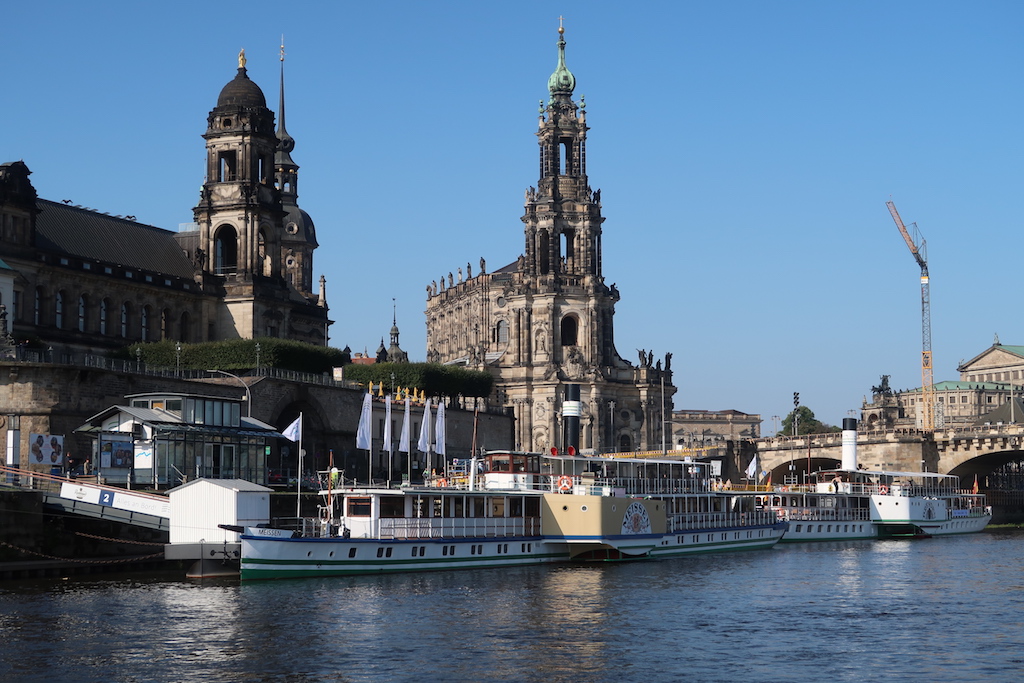
Paddle steamers Meissen and Dresden at the heart of a city that oozes historic stature, having long put behind it the devastation caused by the February 1945 bombing. Dresden lies more than 160 miles from the sea and slightly over halfway from the source of the River Elbe
After discovering the delights of Swiss lake steamers on previous continental holidays, Graeme Hogg and Alex Forrest decided this year to explore the paddle steaming possibilities of the River Elbe in Germany. In the first of two reports from Dresden, Graeme sets the scene for their visit to ‘Saxon Switzerland’, so named because of its scenic beauty.
Earlier this month Alex and I flew to Germany for three days of sailing on some of the paddle steamers based in Dresden. This is the fourth in what has become an annual expedition to visit interesting locations and do some sailing. The first year we fulfilled a joint ambition to visit St Kilda from Harris. In 2017-18 we visited Switzerland, sailing the first year on Lake Geneva and last year on the lakes at Interlaken.
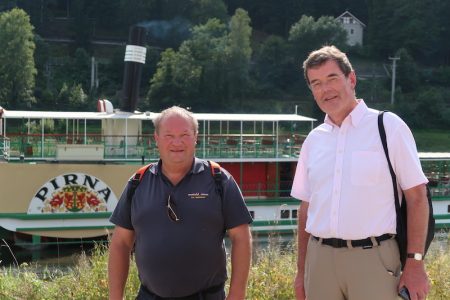
Alex Forrest and Graeme Hogg spent three days sampling the fleet of paddle steamers on the River Elbe in Germany. They are pictured with Pirna of 1898, which can carry 300 passengers but has a deck crew of only two, plus at least three catering staff
This year we chose Dresden, home to the largest and oldest fleet of paddle steamers in Europe. We had planned the trip back in February, long before Waverley’s problems became apparent, and by the time we set off, Alex in particular was suffering from lack of exposure to paddle steamers. Over May and June I had managed trips on the Kiel Canal on Freya and on Lake Lucerne on Uri, Gallia and Unterwalden, so my symptoms were less acute.
The steamers at Dresden sail on the River Elbe, upstream towards the border with the Czech Republic and sometimes beyond, and downstream to Meissen and the local vineyard area. Dresden itself is over 160 miles from the sea and slightly over halfway from the river’s source. The river is not particularly wide, making turning the ships a tricky operation, and the water level can also cause difficulties, either because there is too much or not enough water. In fact, since the beginning of August, the Sächsiche Dampfschiffahrt company, which operates the steamers, has been running a modified timetable owing to a shortage of water, of which more later.
Since the Dresden ships are less well known than their Swiss counterparts, it may be worth giving some background. Shipping operations began in the area in 1837 and developed through the 19th century. From an early stage the company had its own shipyard at Blasewitz, later moved further upstream to Laubegast, where it remains. By 1901 the fleet comprised 36 ships, all paddlers with a shallow draught. The company continued to prosper up to World War II. The fleet suffered considerable damage in the terrible air-raid on Dresden in February 1945 and that, combined with reparations to Czechoslovakia, left it with only eight operational vessels at the end of the war.
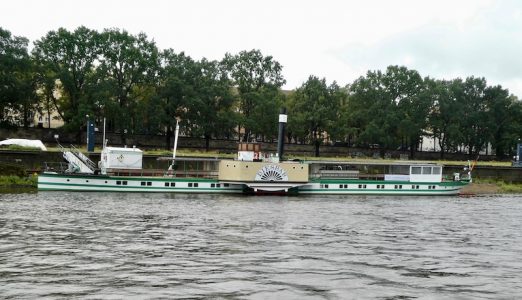
Diesbar, built in 1884 but with an engine originally constructed in 1841, was declared an historic monument in 1980
Dresden was now part of East Germany, and the newly nationalised company quickly built up the fleet again by repairing war damaged ships, so that it comprised 26 ships by 1948. In the 1963-64 period four modern diesel-electric paddlers were added. The fleet survived relatively well through the communist era, and Diesbar, built in 1884 but with an engine originally constructed in 1841, was declared an historic monument in 1980. Reconstructed in the late 1980s, she remains part of the fleet and is the only coal fired ship.
With the unification of Germany in 1989, the chill winds of capitalism might have been expected to spell the end for a fleet of aged paddle steamers. However, in 1992 the fleet was privatised and is now operated by Conti, an international shipping company, which is joint owner with the Government of Saxony. It was the relatively new diesel-electric paddlers which were withdrawn. The eight remaining steamers were retained and were all reconditioned to a high standard. Two large motor ships, similar to many operating in inland waterways across Europe, were built. The fleet was further added to in 1999 with the purchase from Meissen owners of the paddle steamer Krippen of 1892.
What of the ships themselves? The nine paddle steamers range in age from Stadt Wehlen of 1879, celebrating her 140th anniversary this year, to the youngster of the fleet, Leipzig, built as recently as 1929, and so celebrating her 90th anniversary. The design principles are consistent across the fleet. The sponsons are short, like Waverley’s, rather than running the length of the ship in the manner of most continental paddlers. The lower deck of each ship has saloons fore and aft with sizeable windows rather than portholes, although these are set quite high: you cannot easily view the scenery when sitting down.

‘The sponsons are short, like Waverley’s, rather than running the length of the ship in the manner of most continental paddlers’: this photograph was taken on the 90-year old Leipzig, one of the younger steamers in the River Elbe fleet
The four largest ships have deck saloons at main deck level, with alleyways running down each side which, given the narrow beam, results in limited accommodation in the shelters. The smaller ships lack deck shelters, but are provided with canopies over the main deck aft and partly forward. Above this deck all ships except Diesbar and Krippen have some open accommodation under a canopy.
As there are many low bridges on the river, masts are very short, with provision to make them taller. Funnels, which range from tall to very tall, have to be folded back to pass under the bridges. This is accomplished by a winch and pulley arrangement.
The ships fall into four groups. The youngest two, Dresden (1926) and Leipzig, which are virtually identical, are the largest at 70.10 metres (230 feet) and have two-crank compound diagonal engines. They use superheated steam, and by driving a pump from the main crankshaft, the surging motion found on many two-crank paddle steamers is minimised, although this may also be helped by the relatively low operating speed.
Speeds vary from five to 10 knots, depending on the current and whether passage is upstream or downstream. They can carry 610 passengers. Their fuel consumption is about 130 litres/hour, which is about 20% of Waverley’s. Crew consists of Captain, Mate, Purser/deckhand, Engineer and three-plus catering staff, depending on how busy the ship is expected to be.
All the other steamers are powered by two-crank oscillating engines. This type of propulsion was already regarded as slightly anachronistic on the Clyde when installed in Columba in 1878. She was so powered because the engine motion is essentially vertical and provides a smoother passage than diagonal machinery. Columba and Iona were the last steamers on the Clyde to use oscillating engines and they were withdrawn at the end of the 1935 season, so there are now very few people who will have experienced this form of propulsion — unless they have been to Dresden or a couple of other locations where such engines are still to be found.
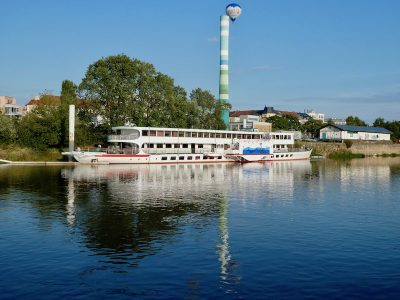
One of the old diesel paddlers
The sister ships Meissen (1885) and Pillnitz (1886) are the only others equipped with deck shelters. They are 65.70 metres (216 feet) in length and carry 350 passengers.
The big drop in capacity is because these ships are some 1.7 metres (5.5 feet) narrower in the beam. Their crew complement is similar. Fuel consumption is about 100-120 litres/hour and they are slightly slower than their larger sisters.
The next class down in size contains three ships: Stadt Wehlen (1879), Kurort Rathen (1896) and Pirna (1898). They are very similar in appearance and range in length from 59.20 metres (194 feet) in the case of Stadt Wehlen to 57.10 metres (187 feet) for the others.
In spite of being about a metre narrower still, their complement is 300 passengers. Deck crew is only two but catering crew will still be at least 3. Fuel consumption is 100 litres/hour.
The last two ships are Diesbar (1884) and Krippen (1892). The former is 53.5 metres (175 feet) and the latter 56.10 metres (184 feet). They are used mainly on charter sailings and their complement is smaller than the other ships. Crew is similar, but Diesbar also has to carry a stoker, being coal fired. The engines are not compound and fuel consumption is 125 litres/hour for Krippen and 450kg/hour of coal for Diesbar.
Coming soon: Part 2 of ‘Destination Dresden’, in which Graeme and Alex sample excursions upstream and downstream on the River Elbe: “Whereas the run to Pillnitz had taken 2 hours and 10 minutes, the run back was only 1 hour 25 minutes, such is the effect of the current.”
All photographs on this page are © Graeme Hogg and Alex Forrest.

With a length of 230 feet, Leipzig is joint largest of the River Elbe paddle steamer fleet. She can carry 610 passengers

At the heart of ‘Saxon Switzerland’

Stadt Wehlen basks in the morning light at Dresden: this year she celebrated her 140th anniversary
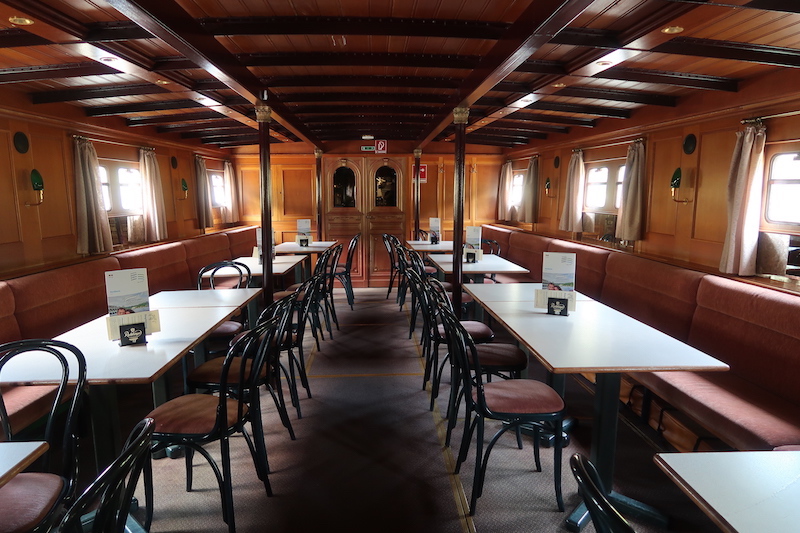
Forward saloon on Stadt Wehlen
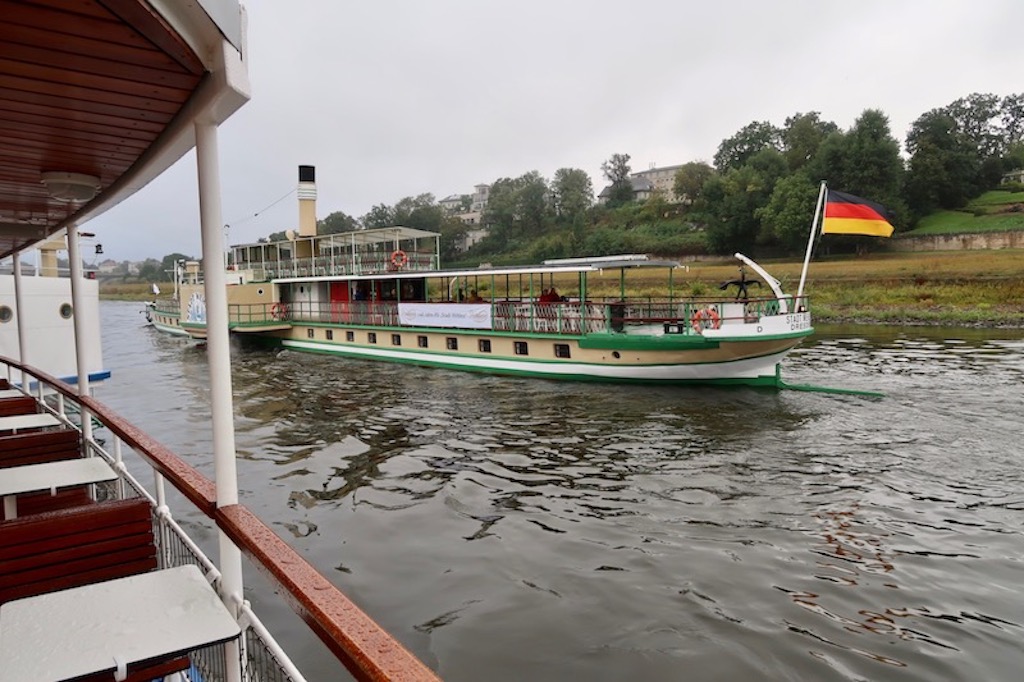
Close encounter: Stadt Wehlen, pictured from the deck of Leipzig on the River Elbe

Pillnitz of 1886 near Dresden: all the Elbe paddlers are shallow-draught
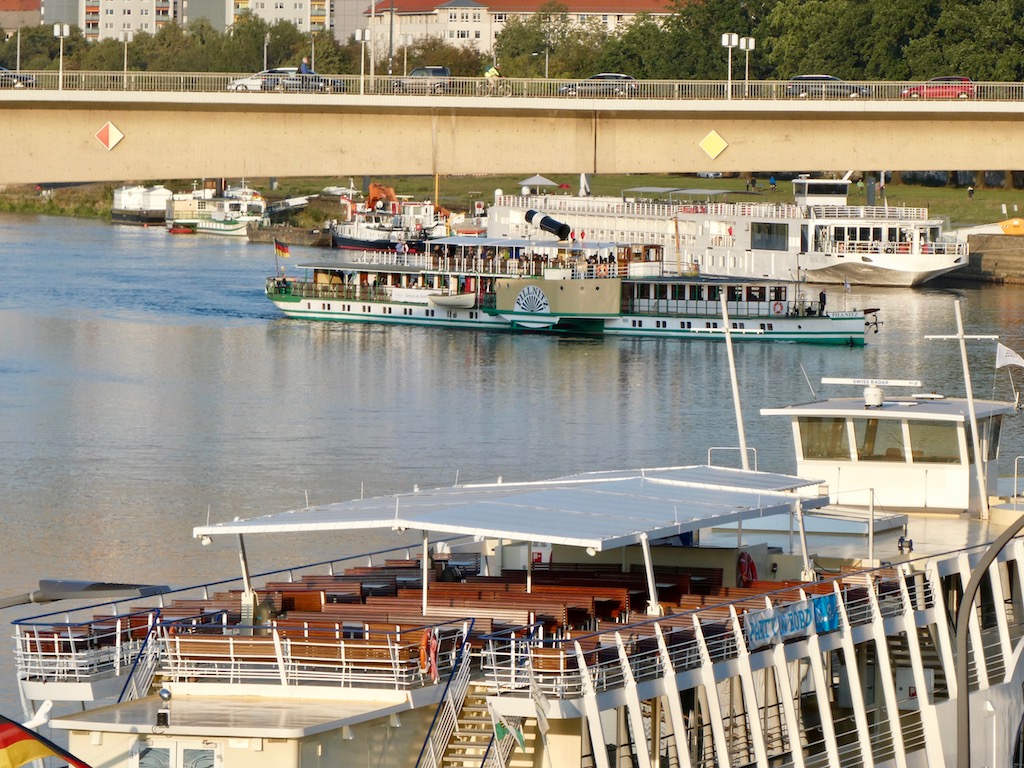
Pillnitz turning in the river at Dresden: note the collapsible funnel
Further reading: Discovering the Swiss paddlers — Graeme and Alex on holiday at Interlaken
Published on 28 September 2019











